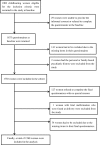Effects of midwife-led maternity services on postpartum wellbeing and clinical outcomes in primiparous women under China's one-child policy
- PMID: 30103732
- PMCID: PMC6090670
- DOI: 10.1186/s12884-018-1969-9
Effects of midwife-led maternity services on postpartum wellbeing and clinical outcomes in primiparous women under China's one-child policy
Abstract
Background: The Midwife-led maternity services have been implemented in China in response to the high rates of primiparous women and Caesarean Sections (CS) which may be related to China's one-child policy. However, few studies in China have been reported on the effectiveness of Midwife-led Care at Delivery (MCD) and the Continuity of Midwife-led Care (CMC) on postpartum wellbeing and other clinical outcomes. Therefore, evidence-based clinical validation is needed to develop an optimal maternity service for childbearing women in China.
Methods: A concurrent cohort study design was conducted with 1730 pregnant women recruited from 9 hospitals in Shanghai. Among the 1730 participants at baseline, 1568 participants completed the follow-up questionnaire, with a follow-up rate of 90.6%.
Results: Compared with the routine Obstetrician-led Maternity Care (OMC), Midwife-led Care at Delivery (MCD) was associated with CS rate (OR were 0.16; 95%CI: 0.11 to 0.25) and a higher total score of postpartum wellbeing (βwere 2.70; 95%CI: 0.70 to 4.70) when adjusting for the baseline differences and other confounders during delivery or postpartum period. Moreover, continuity of Midwife-led Care (CMC) was associated with CS rate (OR were 0.30; 95%CI: 0.23 to 0.41), as well as increased rate of breastfeeding within the first 24 h (OR were 2.49; 95% CI: 1.47 to 4.23), higher postpartum satisfaction (β = 4.52; 95% CI: 1.60 to 12.68), lower anxiety (βwere 0.66; 95% CI: 0.16 to 1.17), increased self-control (βwere 0.39; 95% CI: 0.02 to 0.76) and a higher total score of postpartum wellbeing (βwere 3.14; 95% CI: 1.54 to 4.75).
Conclusion: CMC is the optimal service for low-risk primiparous women under China's one-child policy, and is worthwhile for a general implementation across China.
Keywords: China’s one-child policy; Midwife-led maternity services; Postpartum wellbeing.
Conflict of interest statement
Ethical clearance was obtained from the ethics committees of the Shanghai First Maternity and Infant Hospital (KS1658). The study was carried out in accordance with the approved guidelines. The purposes of the study were explained to all participants verbally. Participants were assured of the confidentiality and anonymity. All participants signed an informed consent form prior to enrolment in the study. The participants were advised that they could withdraw from the study at any time they wished.
Not applicable.
The authors declare that they have no competing interests. The funding from National Natural Science Foundation of China under Grant(81,673,179, 81,402,687), the Shenkang Hospital Development Center under Grant(SHDC12016239,16CR1014A) play the roles in the study design and data collection. The study is also supported by the Fourth Round of Shanghai Three-year Action Plan on Public Health Discipline and Talent Program: Women and Children’s Health under Grant (15GWZK0401), Shanghai Municipal Commission of Health and Family Planning under Grant (201,640,060,2017ZZ02015) for analysis and interpretation of data and in writing and revising the manuscript.
Springer Nature remains neutral with regard to jurisdictional claims in published maps and institutional affiliations.
Figures
Similar articles
-
Women's experience and satisfaction with midwife-led maternity care: a cross-sectional survey in China.BMC Pregnancy Childbirth. 2021 Feb 19;21(1):151. doi: 10.1186/s12884-021-03638-3. BMC Pregnancy Childbirth. 2021. PMID: 33607963 Free PMC article.
-
The effectiveness of a Chinese midwives' antenatal clinic service on childbirth outcomes for primipare: a randomised controlled trial.Int J Nurs Stud. 2013 Dec;50(12):1689-97. doi: 10.1016/j.ijnurstu.2013.05.001. Epub 2013 Jun 2. Int J Nurs Stud. 2013. PMID: 23735597 Clinical Trial.
-
Maternity service organisational interventions that aim to reduce caesarean section: a systematic review and meta-analyses.BMC Pregnancy Childbirth. 2019 Jul 9;19(1):206. doi: 10.1186/s12884-019-2351-2. BMC Pregnancy Childbirth. 2019. PMID: 31286892 Free PMC article.
-
Effects of a midwife psycho-education intervention to reduce childbirth fear on women's birth outcomes and postpartum psychological wellbeing.BMC Pregnancy Childbirth. 2015 Oct 30;15:284. doi: 10.1186/s12884-015-0721-y. BMC Pregnancy Childbirth. 2015. PMID: 26518597 Free PMC article. Clinical Trial.
-
Midwife-Led Continuity of Antenatal Care and Breastfeeding Duration Beyond Postpartum Hospital Discharge: A Systematic Review.J Hum Lact. 2023 Aug;39(3):427-440. doi: 10.1177/08903344221126644. Epub 2022 Oct 5. J Hum Lact. 2023. PMID: 36197006
Cited by
-
Effectiveness of midwifery-led care on pregnancy outcomes in low- and middle-income countries: a systematic review and meta-analysis.BMC Pregnancy Childbirth. 2023 May 26;23(1):386. doi: 10.1186/s12884-023-05664-9. BMC Pregnancy Childbirth. 2023. PMID: 37237358 Free PMC article.
-
Impact of a quality improvement program: Early initiation of breastfeeding after cesarean section in a tertiary care hospital, in Eastern India.Med J Armed Forces India. 2023 May-Jun;79(3):309-315. doi: 10.1016/j.mjafi.2021.09.002. Epub 2021 Nov 10. Med J Armed Forces India. 2023. PMID: 37193520 Free PMC article.
-
Midwifery continuity of care: A scoping review of where, how, by whom and for whom?PLOS Glob Public Health. 2022 Oct 5;2(10):e0000935. doi: 10.1371/journal.pgph.0000935. eCollection 2022. PLOS Glob Public Health. 2022. PMID: 36962588 Free PMC article.
-
Effect of midwife-led care models on maternal and fetal outcomes: A scoping review.Bioinformation. 2025 May 31;21(5):957-961. doi: 10.6026/973206300210957. eCollection 2025. Bioinformation. 2025. PMID: 40822759 Free PMC article.
-
Women's experience and satisfaction with midwife-led maternity care: a cross-sectional survey in China.BMC Pregnancy Childbirth. 2021 Feb 19;21(1):151. doi: 10.1186/s12884-021-03638-3. BMC Pregnancy Childbirth. 2021. PMID: 33607963 Free PMC article.
References
-
- Blackman I, Sweet L, Byrne J. Using Rasch analysis to identify midwifery students' learning about providing breastfeeding support. Women Birth pii: S1871–5192. (15):00017–7. 10.1016/j.wombi.2015;02.001. - PubMed
-
- Hodnett ED. Update Software. Oxford: The Cochrane Library; 2001. Continuity of Care Givers for Care During Pregnancy and Childbirth.
Publication types
MeSH terms
Grants and funding
- 81673179,81402687,/National Natural Science Foundation of China
- SHDC12016239,16CR1014A/the Shenkang Hospital Development Center
- 15GWZK0401/the Fourth Round of Shanghai Three-year Action Plan on Public Health Discipline and Talent Program: Women and Children's Health
- 201640060,2017ZZ02015/Shanghai municipal medical and health discipline construction projects
LinkOut - more resources
Full Text Sources
Other Literature Sources
Medical


